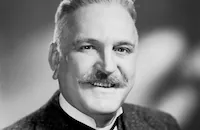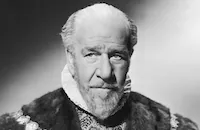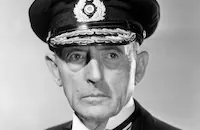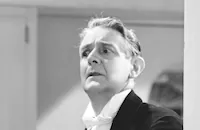The Emperor's Candlesticks

Brief Synopsis
Cast & Crew
George Fitzmaurice
William Powell
Luise Rainer
Robert Young
Maureen O'sullivan
Frank Morgan
Film Details
Technical Specs

Synopsis
In Vienna, in the early part of the twentieth century, the Grand Duke Peter, son of the Russian czar, goes to a masked ball dressed as Romeo, accompanied by Colonel Baron Suroff. When Peter meets the lovely Maria Orlech, who is dressed as Juliet, she lures him to a house where Korum, a Polish nationalist, demands that he write the czar to demand the release Maria's father, condemned patriot Thaddeus Orlech. Korum then asks Polish agent Baron Stephan Wolensky to transport Peter's letter to St. Petersberg. Soon after this, Pavloff, a Russian official, asks his agent, Countess Olga Mironova, to stop Stephan. The next day, Stephan visits his old friend, Prince Johan, who asks him to transport a pair of candlesticks to a Russian princess. When Johan notices a hidden compartment in one of the candlesticks, he agrees and secretly places the letter inside the compartment. Later, Olga also visits Johan and hides a document from from Pavloff demanding Stephan's arrest in one of the candlesticks, unaware that Stephan has hidden Peter's letter in the other. She also begs Johan to let her transport them for him instead of Stephan. As Stephan and Olga travel toward Russia on the same train, Olga's maid, Mitzi Reisenbach, helps her lover Anton to steal Olga's luggage, not knowing that they carry the candlesticks instead of jewels. At a Russian train station, when Stephan sees a notice stating that Olga has posted a reward for the recovery of some stolen property, he goes to see her. He arrives just as Anton is arrested and Mitzi gets on a train, then casually offers to help Olga recover her property. When the police question Anton, he says that he gave the candlesticks to a "lady," and Stephen, who is present during the interrogation, realizes that the large basket Mitzi was carrying as she boarded the train must have contained the candlesticks. As Olga and Stephan both travel throughout Europe looking for Mitzi, they become infatuated, even though they try to outwit each other. When Stephan finally locates Mitzi, she says she sold the candlesticks to an antiques dealer named Santuzzi, at whose shop Stephan again meets Olga. Santuzzi also has sold the candlesticks, necessitating Olga and Stephan's separate journeys to Paris, and finally to London, where they try to outbid each other for the candlesticks at an auction. Compelled to pool their money to pay the auction house after their bidding escalates the price, each leaves with the candlestick he thinks contains the secret papers. Olga realizes she has the candlestick with his papers, just as Stephen realizes that he has the one with hers. He then comes to her hotel and promises to save her life by giving her papers back, but only after his papers arrive safely. Meanwhile, in Vienna, Korum and the others decide to kill Peter, thinking that Stephan has failed, but Maria makes them promise to wait a few more days. She also begs Peter to forgive her when she realizes that she has become fond of him. After the letter is successfully smuggled to the czar, Maria's father is released and Peter and the Baron are set free. Immediately after, Stephan is ordered to go before the czar, and Colonel Radoff of the Russian secret service deduces that Olga has has betrayed him. While Radoff is at Olga's house to arrest her, Stephen arrives with the other candlestick and, after he gives her the papers, she burns them as Radoff watches. When Stephan and Olga go before the czar, he is impressed with their love and loyalty to each other and allows them to go free, after which they leave Russia to marry.

Director

George Fitzmaurice
Cast

William Powell

Luise Rainer

Robert Young

Maureen O'sullivan

Frank Morgan

Henry Stephenson
Bernadene Hayes
Donald Kirke

Douglas Dumbrille
Charles Waldron

Ien Wulf
Barnett Parker

Frank Reicher
Bert Roach
Paul Porcasi

E. E. Clive
Emma Dunn

Frank Conroy
Spencer Charters
Theodor Von Eltz
Mitchell Lewis
Egon Brecher
Erville Alderson
Clarence H. Wilson
Rollo Lloyd
Maude Turner Gordon
Lionel Pape
William Stack
Ramsey Hill
Olaf Hytten
Torben Meyer
Davison Clark
Harvey Clark

King Baggott
George Davis
Russ Powell
Clarice Sherry
Frank Dawson

Leonard Carey
Mariska Aldrich
John Picorri
Roland Varno
Sidney Bracy
Eva Dennison
Herbert Evans
George Kirby
Cyril Thornton
Vernon P. Downing
Bruce Mitchell
Agostino Borgato
Crew
Adrian
Daniel Cathcart
John W. Considine Jr.
Cedric Gibbons
Harold Goldman
Monckton Hoffe
Herman Mankiewicz
Herman J. Mankiewicz
Oliver T. Marsh
John Meehan
Hugh Mills
Conrad A. Nervig
Baroness Orczy
Harold Rosson
Douglas Shearer
Erich Von Stroheim
Slavko Vorkapich
Franz Waxman
Edwin B. Willis
Edward Woehler

Videos
Movie Clip



Trailer
Film Details
Technical Specs

Articles
The Emperor's Candlesticks
It wasn't for lack of trying by MGM. The studio lavished huge amounts of money and effort on the film, a true 'A' production with a formidable cast and sumptuous sets and costumes. Rainer's leading man was William Powell, who had previously starred with her in Escapade (1935), her first film, and The Great Ziegfeld. Joining them were fellow stars Robert Young and Maureen O'Sullivan, and supporting them were such stalwarts as Frank Morgan and Henry Stephenson. Even 18-year-old future star Carole Landis pops up in a bit part here, in one of her first screen appearances.
The story, based on a novel by Scarlet Pimpernel author Baroness Emmuska Orczy, is a spy yarn set all over pre-WWI Europe, with Rainer and Powell as rival spies after a pair of candlesticks in which are hidden state secrets. To audiences and critics of the time, the far-fetched and incoherent proceedings couldn't be saved by the considerable star presence. Today, it's that glossy star power, given the full MGM treatment, which makes The Emperor's Candlesticks fun to watch. (For the record, an Austrian version of the Orczy novel beat this MGM version to the screen by one year.)
Maureen O'Sullivan had already made three Tarzan movies by this point as well as many other excellent films. Eleven days before The Emperor's Candlesticks opened, she could be seen with the Marx Brothers in A Day at the Races (1937). For her relatively small part here, film historian Connie Billips has written, O'Sullivan boned up on authentic period hairdresses, "a consideration not many would undertake."
Rainer's Oscar® is probably the reason why MGM rushed The Emperor's Candlesticks through postproduction and released it in July 1937, only three months after shooting wrapped. By then, Rainer was already well into filming her next movie, Big City (1937), a Frank Borzage-directed production she thought unwatchable but worth seeing for Rainer, Borzage and Spencer Tracy fans. Adding to the busy schedule for Rainer was her recent marriage to Clifford Odets, a union that would last only three years.
Rainer later reflected on her brief Hollywood career, saying, "For my second and third pictures I won Academy Awards. Nothing worse could have happened to me." Rainer would end up with the last laugh, though: as of late 2009, she is nearing her 100th birthday.
Producer: John W. Considine, Jr.
Director: Geo. Fitzmaurice
Screenplay: Harold Goldman, Monckton Hoffe; Baroness Orczy (book)
Cinematography: Harold Rosson, Oliver T. Marsh (uncredited)
Art Direction: Cedric Gibbons
Music: Franz Waxman
Film Editing: Conrad A. Nervig
Cast: William Powell (Baron Stephan Wolensky), Luise Rainer (Countess Olga Mironova), Robert Young (Grand Duke Peter), Maureen O'Sullivan (Maria Orlich), Frank Morgan (Col. Baron Suroff), Henry Stephenson (Prince Johann), Bernadene Hayes (Mitzi Reisenbach), Donald Kirke (Anton the Thief), Douglas Dumbrille (Mr. Korum a Conspirator), Charles Waldron (Dr. Malchor a Conspirator), Ien Wulf (Leon a Conspirator)
BW-89m.
by Jeremy Arnold

The Emperor's Candlesticks
Quotes
Trivia
Notes
This was the third and final film in which Luise Rainer and William Powell co-starred. The first, Escapade, was released in 1935, and the second, The Great Ziegfeld, was released in 1936 ( and below). An Austrian film based on the Baroness Orczy novel was made in 1936 under the title Die Leuchter des Kaisers.















